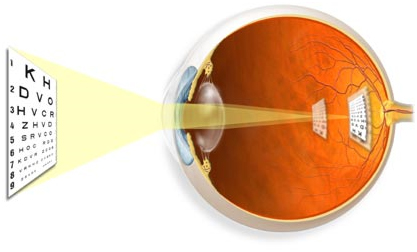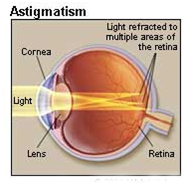Overview
"What Is A Stigmatism?" Is A Question That Eye Doctors Hear Every Day, But Actually It's Spelled "Astigmatism." Although Astigmatism Is The Most Common Vision Problem, Most People Don't Know What It Is.
Astigmatism May Accompany Farsightedness Or Nearsightedness. Usually It Is Caused By An Irregularly Shaped Cornea (Called Corneal Astigmatism). But Sometimes Lenticular Astigmatism Results From An Irregularly Shaped Lens, Which Is Located Behind The Cornea.

The Two Most Common Types Of Astigmatism Are : -
- Corneal Astigmatism - The Cornea Has An Irregular Shape
- Lenticular Astigmatism - The Lens Has An Irregular Shape
What Causes Astigmatism?
 Astigmatism Can Be Hereditary And Is Often Present At Birth. It Can Also Result From Pressure From The Eyelids On The Cornea, Incorrect Posture Or An Increased Use Of The Eyes For Close Work.
Astigmatism Can Be Hereditary And Is Often Present At Birth. It Can Also Result From Pressure From The Eyelids On The Cornea, Incorrect Posture Or An Increased Use Of The Eyes For Close Work. Astigmatism Occurs Due To The Irregular Shape Of The Cornea Or The Lens Inside The Eye. The Cornea And Lens Are Primarily Responsible For Properly Focusing Light Entering Your Eyes Allowing You To See Things Clearly.
The Curvature Of The Cornea And Lens Causes Light Entering The Eye To Be Bent In Order To Focus It Precisely On The Retina At The Back Of The Eye. In Astigmatism, The Surface Of The Cornea Or Lens Has A Somewhat Different Curvature In One Direction Than Another. In The Case Of The Cornea, Instead Of Having A Round Shape Like A Basketball, The Surface Of The Cornea Is More Like A Football. As A Result, The Eye Is Unable To Focus Light Rays To A Single Point Causing Vision To Be Out Of Focus At Any Distance.
How Is Astigmatism Diagnosed?
The Ophthalmologist, Optometrist, Or Orthoptist May Use The Following Tools To Examine The Eyes : -
- Visual Acuity Test - This Involves Reading Letters On A Chart. The Letters Become Progressively Smaller On Each Line.
- Astigmatic Dial - This Is A Chart Showing A Series Of Lines Which Make Up A Semi-Circle. People With Perfect Vision Will See The Lines Clearly, While Those With Astigmatism Will See Some More Clearly Than Others.
- Keratometer - Also Known As An Ophthalmometer. This Device Measures The Reflected Light From The Surface Of The Cornea. It Measures The Radius Of The Curvature Of The Cornea And Can Assess The Degree Of Abnormal Curvature Of The Cornea.
- Keratoscope - Also Known As Placido's Disk - This Device Is Marked With Lines Or Circles And Observes Corneal Reflex. It Uses Light To Project Rings On The Cornea. By Measuring The Spacing Between The Rings It Calculates The Variations Of Curvature, Which In Turn Calculates The Degree Of Astigmatism. A Videokeratoscope Is A Keratoscope Fitted With A Video.
- The Importance Of Regular Eye Tests - Astigmatism Is Very Common - Experts Say Most Of Us Are Born With A Degree Of Astigmatism. Most Children Who Are Born With Astigmatism Will Not Realize They Have It Until They Have An Eye Test. Reading And Concentrating At School May Be Affected If A Child Has Undiagnosed Astigmatism. Therefore, Regular Eye Tests Are Important.
What Are The Symptoms Of Astigmatism?
- Blurred Or Distorted Vision At All Distances.
- Photophobia - Sensitivity To Light.
- Headaches.
- Excessive Squinting.
- The Person Is Constantly Closing His/Her Eyes.
- Eye Strain - Occurs More Often When The Eye Has To Focus For Long Periods, As In Reading From Paper Or A Computer Monitor.
How Is Astigmatism Treated?
They Include : -
- Eyeglasses
- Contact Lenses
- Orthokeratology
- Laser And Other Refractive Surgery Procedures
Laser-Assisted In Situ Keratomileusis (LASIK) Is The Most Commonly Performed Refractive Procedure - A Flap Is Cut Through The Top Of The Cornea, A Laser Removes Some Corneal Tissue And Then The Flap Is Dropped Back Into Place. It Smoothes An Irregular Cornea Into A More Normal Shape. Astigmatic Keratotomy (AK) Is Also Used To Correct Astigmatism. Incisions Are Strategically Placed On The Steepest Curves. The Steep Areas Flatten, And The Cornea Heals Into A More Spherical Shape.
This Allows Light To Focus More Precisely On The Retina. Astigmatic Keratotomy (AK) Can Be Performed Alone Or In Conjunction With Other Refractive Procedures. Limbal Relaxing Incision (LRI) Is Performed To Correct Mild Astigmatism. This Procedure Is Similar To Radial Keratotomy. Incisions Are Made At The Limbus, (The Visible Borderline Between The Clear Window (Cornea) And The White Globe (Sclera) Of The Eye) And The Cornea Is Made More Spherical And Is Relaxed, To Give A Clear Vision.
For more information, medical assessment and medical quote
as email attachment to
Email : - info@wecareindia.com
Contact Center Tel. (+91) 9029304141 (10 am. To 8 pm. IST)
(Only for international patients seeking treatment in India)










